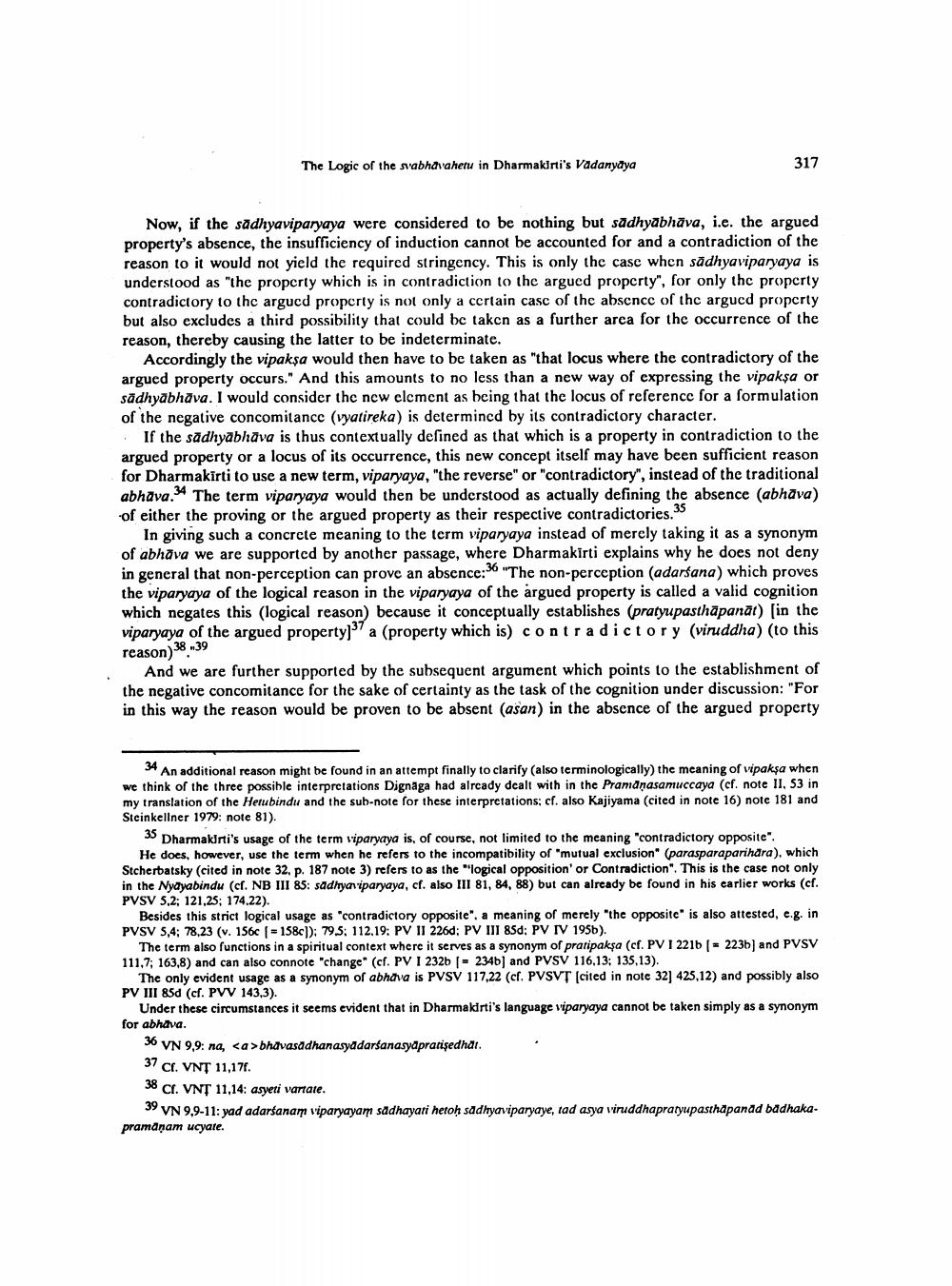Book Title: Logic Of Svabhavahetu In Dhharmakirtis Vadanyaya Author(s): Ernat Steinkellner Publisher: Ernat Steinkellner View full book textPage 7
________________ The Logic of the swabhavahetu in Dharmakirti's Vadanyaya 317 Now, if the sadhyaviparyaya were considered to be nothing but sadhyabhāva, i.e. the argued property's absence, the insufficiency of induction cannot be accounted for and a contradiction of the reason to it would not yield the required stringency. This is only the case when sådhyaviparyaya is understood as "the property which is in contradiction to the argued property", for only the property contradictory to the argucd property is not only a certain casc of the absence of the argued property but also excludes a third possibility that could be taken as a further area for the occurrence of the reason, thereby causing the latter to be indeterminate. Accordingly the vipaksa would then have to be taken as "that locus where the contradictory of the argued property occurs." And this amounts to no less than a new way of expressing the vipaksa or sādhyabhāva. I would consider the new clcment as being that the locus of reference for a formulation of the negative concomitancc (vyatireka) is determined by its contradictory character. If the sadhyabhāva is thus contextually defined as that which is a property in contradiction to the argued property or a locus of its occurrence, this new concept itself may have been sufficient reason for Dharmakirti to use a new term, viparyaya, "the reverse" or "contradictory", instead of the traditional abhava.34 The term viparyaya would then be understood as actually defining the absence (abhāva) of either the proving or the argued property as their respective contradictories." In giving such a concrete meaning to the term viparyaya instead of merely taking it as a synonym of abhāva we are supported by another passage, where Dharmakirti explains why he does not deny in general that non-perception can prove an absence:36 "The non-perception (adarśana) which proves the viparyaya of the logical reason in the viparyaya of the argued property is called a valid cognition which negates this (logical reason because it conceptually establishes (pratyupasthapanat) [in the viparyaya of the argued property137 a (property which is) contradictory (viruddha) (to this reason) 38-39 And we are further supported by the subsequent argument which points to the establishment of the negative concomitance for the sake of certainty as the task of the cognition under discussion: "For in this way the reason would be proven to be absent (asan) in the absence of the argued property An additional reason might be found in an attempt finally to clarify (also terminologically) the meaning of vipaksa when we think of the three possible interpretations Dignaga had alrcady dealt with in the Pramanasamuccaya (cf. note II, 53 in my translation of the Hetubindu and the sub-note for these interpretations; cf. also Kajiyama (cited in note 16) note 181 and Steinkellner 1979: note 81). Dharmakirti's usage of the term viparyaya is, of course, not limited to the meaning "contradictory opposite". He does, however, use the term when he refers to the incompatibility of mutual exclusion" (parasparaparihara), which Stcherbatsky (cited in note 32. p. 187 note 3) refers to as the "logical opposition' or Contradiction. This is the case not only in the Nyayabindu (cf. NB III 85: sadyan iparyaya, cf. also III 81, 84, 88) but can already be found in his earlier works (cf. PVSV 5.2; 121,25; 174.22). Besides this strict logical usage as 'contradictory opposite'. a meaning of merely "the opposite is also attested, c.g. in PVSV 5,4; 78.23 (v. 156c158c]): 79.5: 112.19: PV 11 226d: PV III 8Sd: PV IV 195b). The term also functions in a spiritual context where it serves as a synonym of pratipaksa (cf. PV 1221b - 223b) and PVSV 111,7; 163,8) and can also connote "change" (cf. PV I 232b - 234b) and PVSV 116,13; 135,13). The only evident usage as a synonym of abhava is PVSV 117,22 (cf. PVSVT (cited in note 32J 425,12) and possibly also PV III 85d (cf. PWV 143.3). Under these circumstances it seems evident that in Dharmakirti's language viparyaya cannot be taken simply as a synonym for abhava. 36 VN 9,9: na, <a>bhavasadhanasyddarsanasyapratisedhat. 37 C. VNT 11,176. 38 C. VNT 11,14: asyeti vartale. 39 VN 9,9-11: yad adarśanam viparyayam sadhayati hetoh sadhyaviparyaye, tad asya viruddhapratyupasthapanad badhakapramanam ucyate.Page Navigation
1 ... 5 6 7 8 9 10 11 12 13
